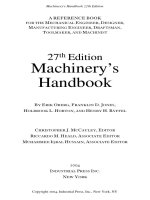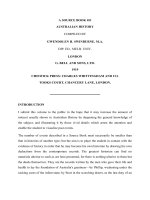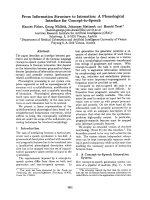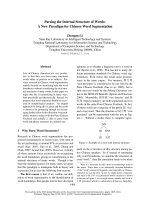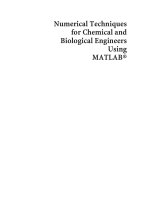A015 structure as architecture a source book for architects and structural engineers
Bạn đang xem bản rút gọn của tài liệu. Xem và tải ngay bản đầy đủ của tài liệu tại đây (7.97 MB, 241 trang )
STRUCTURE AS ARCHITECTURE
This page intentionally left blank
STRUCTURE AS
ARCHITECTURE
A SOURCE BOOK
FOR ARCHITECTS AND
STRUCTURAL ENGINEERS
Andrew W. Charleson
AMSTERDAM • BOSTON • HEIDELBERG • LONDON • NEW YORK • OXFORD
PARIS • SAN DIEGO • SAN FRANCISCO • SINGAPORE • SYDNEY • TOKYO
Architectural Press is an imprint of Elsevier
An imprint of Elsevier
Linacre House, Jordan Hill, Oxford OX2 8DP
30 Corporate Drive, Burlington MA 01803
First published 2005
Copyright © 2005, Andrew W. Charleson
All rights reserved
The right of Andrew W. Charleson to be identified as the author of this work has been
asserted in accordance with the Copyright, Designs and Patents Act 1988
No part of this publication may be reproduced in any material form (including
photocopying or storing in any medium by electronic means and whether or not
transiently or incidentally to some other use of this publication) without the written
permission of the copyright holder except in accordance with the provisions of the
Copyright, Designs and Patents Act 1988 or under the terms of a licence issued by
the Copyright Licensing Agency Ltd, 90 Tottenham Court Road, London, England
W1T 4LP. Applications for the copyright holder’s written permission to reproduce
any part of this publication should be addressed to the publisher
Permissions may be sought directly from Elsevier’s Science and Technology Rights
Department in Oxford, UK: phone: (ϩ44) (0) 1865 843830; fax: (ϩ44) (0) 1865 853333;
e-mail: You may also complete your request
on-line via the Elsevier homepage (www.elsevier.com), by selecting ‘Customer Support’ and
then ‘Obtaining Permissions’
Every effort has been made to contact owners of copyright material; however, the
authors would be glad to hear from any copyright owners of material produced in this
book whose copyright has unwittingly been infringed.
British Library Cataloguing in Publication Data
A catalogue record for this book is available from the British Library
Library of Congress Cataloguing in Publication Data
A catalogue record for this book is available from the Library of Congress
ISBN 0 7506 6527 0
For information on all Architectural Press publications
visit our website at www.architecturalpress.com
Typeset by Charon Tec Pvt. Ltd, Chennai, India
www.charontec.com
Printed and bound in Italy
CONTENTS
Preface
vii
Acknowledgements
xi
1
Introduction
The potential for structure to enrich architecture
Experiencing and reading structure
Structure and its degree of exposure
Book outline
References and notes
1
1
2
4
5
6
2
Two building studies
British Record Industry Trust (BRIT) School
Baumschulenweg Crematorium
Summary
References and notes
7
7
13
18
18
3
Relationships between architectural and structural form
Introduction
Synthesis of architectural and structural form
Consonant forms
Contrasting forms
Summary
References and notes
19
19
23
34
41
50
50
4
Building exterior
Introduction
Aesthetic qualities
Connecting the exterior to the interior
Entry
Expressive roles
Summary
References and notes
51
51
53
65
68
70
77
77
5
Building function
Introduction
Maximizing functional flexibility
Subdividing space
Articulating circulation
Disrupting function
79
79
80
85
93
96
vi
CONTENTS
Summary
References and notes
100
101
6
Interior structure
Introduction
Surface structure
Spatial structure
Expressive structure
Summary
References and notes
103
103
104
112
121
128
129
7
Structural detailing
Introduction
Expressive and responsive detailing
Aesthetic qualities of detailing
Summary
References and notes
131
131
133
151
163
164
8
Structure and light
Introduction
Source of light
Maximizing light
Modifier of light
Modified by light
Summary
References and notes
167
167
168
174
180
184
186
187
9
Representation and symbolism
Introduction
Representation
Symbolism
Summary
References and notes
189
189
190
200
205
206
Conclusions
Introduction
Transformative power of structure
Structural diversity
Implications for the architectural and structural
engineering professions
207
207
208
208
10
209
Index of buildings and references
211
Index
225
PREFACE
This book explores the potential of structure, that is beams, columns,
frames, struts and other structural members, to enrich architecture. At
the most basic level I hope to raise architects’ perception of structure
as an integral element of architecture rather than as just an applied
technology. I also wish to challenge architects to design structure themselves. That is, to attend to all aspects of its design, in collaboration with
structural engineers of course, in order to realize their design concepts.
Where structure contributes architecturally, other than in its primary
load-bearing role, it contributes another layer of aesthetic and functional richness to designs. It increases interest in and enjoyment
of buildings, improves their usability, and raises the spirits of their
occupants.
This book therefore seeks to change a view of structure, common
among architectural students at least, as a purely technical component
of architecture, and at worst, a necessary evil. Examples throughout the
book illustrate structure as an indispensable architectural element that
is thoroughly integrated and involved in the making of architecture, and
playing significant roles that engage the senses, hearts and minds of
building users. As designers, we need to ask ourselves how structure
might assist us to add aesthetic and functional value to our design work,
thereby enriching it.
I write primarily for architectural students and practising architects, but
expect the book will be of more than passing interest to engineering
students and structural engineers who also wish to expand their awareness of the architectural potential of structure. The book, illustrated
with examples from more than one hundred and seventy buildings, is
intended to function both as a source book for architectural design
inspiration and ideas, and as a book to assist designers to reflect upon
their own work. It provides a large resource of very diverse precedents
where structure enhances specific architectural ideas, concepts and
qualities. The index collates these issues and an alphabetical list of all
the case studies discussed provides initial references for further study.
The initial research from which this book has developed began as a literature review. However, limitations in this approach became apparent.
Books for architectural students about structures tend to concentrate
viii
PREFACE
on the mechanics of structural analysis and design, and rarely explore
the architectural implications of structure. Architectural design texts
are also of limited value for this exercise. They certainly describe and
analyse the elements of architecture, including structure, but apart from
examining structure’s space-defining and ordering roles, they throw little light on other areas where structure contributes architecturally. Also,
many of their case studies draw upon pre-twentieth-century masonry
buildings, rather than upon buildings incorporating modern structural
materials and systems. Unfortunately, attempts to analyse structures’
architectural contributions to selected buildings from more general
architectural literature also proved relatively unsuccessful. Due to insufficient written and visual material related specifically to building structures, too many questions about their non-structural roles remained
unanswered. Published photographic images usually provide very limited
and selective views of a building and are a poor substitute for visiting it.
The alternative approach was to undertake field trips, so during the
more intensive periods of research in 1993, 2001 and 2004 I visited,
studied and analysed over two hundred and fifty mainly contemporary
buildings. Most were selected before travelling after visually scanning
many architectural books and periodicals published during the previous
five to ten years. The key selection criterion was the degree to which
their structures contribute architecturally, rather than any other architectural or structural design features. Where practicable, the second
and third field trip itineraries included ‘iconic’ buildings as reviewed in
Thiel-Siling, S. (ed.) (1998) Icons of Architecture: The 20th Century
(Prestel). I approached the chosen buildings as open as possible to any
architectural enrichment their structures might provide. A checklist
helped focus observations and concentration, particularly when activities and displays in and around a building were more engaging than the
structure itself!
By the term analysed I do not refer to quantitative analysis, practised daily
by structural engineers, but rather to a qualitative analytical process
comprising observation and focused reflection – the aim being to deepen
an understanding and appreciation of structural and architectural interactions. Such an analytical process necessitates subjective readings of
structure which inevitably emanate from my thirty years’ experience as
a structural engineer, the last eighteen of which have been spent teaching Structures in a school of architecture.
The scope of the book is limited geographically and by building typology. Not only do my school’s library holdings privilege Western architecture, but the buildings that were selected as worth studying and
PREFACE
ix
could be included in realistic itineraries are located mainly within Western
Europe, and to a more limited extent in North America. Regarding
building typology, domestic dwellings are excluded from the study due to
difficulties accessing them and there being no lack of more public alternatives. A wide range of building sizes is included, but no emphasis is
placed on heroic long-span or high-rise structures whose scale can limit
their relevance as precedents for the more modestly scaled designs
undertaken by architectural students and most architects. Concern for
the buildings’ relevance to readers has also led to a concentration on
contemporary buildings, with most completed during or since the
1990s.
Andrew W. Charleson
This page intentionally left blank
ACKNOWLEDGEMENTS
Various organizations have provided financial support for this project.
The Cement and Concrete Association of New Zealand, the Steel
Construction Industry of New Zealand, the New Zealand Timber
Design Society and Victoria University of Wellington contributed towards
the first field-study costs in 1992. Their generosity, repeated for a second trip in 2001, was supplemented by university summer research
grants before, between and after those trips. Victoria University also
funded the final field study to the USA in 2004.
I am most grateful for several research assistants who have brought
much to this work. Jim McKie and Virginia Jamieson were involved at
that delicate stage when the research was in its infancy and they were
followed by Greg Miller who assisted with the preparatory work for the
2001 study trip. Sam Martin and Katherine Bowron continued when the
book was taking shape, bringing the perspectives of senior architectural
students to bear on the chapter drafts. Katherine produced the
diagrams.
Numerous colleagues in the Schools of Architecture and Design have
made helpful contributions. Comments from Mark Taylor, Julieanna
Preston, Martin Hanley, Anna Kemble Welch, Christina McKay,
Elizabeth and Peter Russell, Geoff Thomas, Robin Skinner and George
Baird have helped improve and resolve the first two chapters, particularly in their early stages. The advice of John Gray and Werner
Osterhaus, and the assistance of the Schools of Architecture and
Design library staff has also been greatly appreciated. Paul Hillier and
Ella Reed of the photographic section have worked with hundreds of
images while Peter Ramutenas and Brent Hardy have provided necessary computer support.
Finally, thanks to my wife, Annette, for her support and encouragement
throughout the project.
Unless otherwise noted, photographs are by the author.
This page intentionally left blank
1
INTRODUCTION
. . . structure is columnar, planar, or a combination of these which a designer can
intentionally use to reinforce or realize ideas. In this context, columns, walls and
beams can be thought of in terms of concepts of frequency, pattern, simplicity, regularity, randomness and complexity. As such, structure can be used to define space,
create units, articulate circulation, suggest movement, or develop composition and
modulations. In this way, it becomes inextricably linked to the very elements which
create architecture, its quality and excitement.1
T HE POTENTIAL FOR STRUCTURE TO ENRICH ARCHITECTURE
Clark and Pause’s statement above begins by describing the architectural qualities of structure and then suggests how structure might
enrich architecture. But is such a positive attitude to structure realistic?
What was the last building you experienced where structure either
created the architecture or contributed a sense of excitement to it?
Where do we find examples of structure playing such active architectural roles as defining space and modulating surfaces? And, how else
might structure contribute architecturally? These questions set the
agenda of this book, informing its focus and scope and initiating an
exploration of architecturally enriching structure.
Some readers may consider Clark and Pause’s attitude towards structure as a fully integrated architectural element rather unrealistic. So
often our day-to-day experience of structure can be described as
unmemorable. In much of our built environment structure is either
concealed or nondescript. Opaque façade panels or mirror-glass panes
hide structure located on a building’s perimeter. Inside a building,
suspended ceilings conceal beams, and vertical structural elements
like columns, cross-bracing and structural walls are either enveloped
within partition walls or else visually indistinguishable from them. Even
if structure is exposed, often its repetitive and predictable configuration
in plan and elevation, as well as its unrefined member and connection
detailing can rarely be described as ‘creating architecture, its quality and
excitement’.
Fortunately, in addition to these ubiquitous and bland structural
encounters, sufficient precedents of positive structural contributions to
2
STRUCTURE AS ARCHITECTURE
architecture exist. They point towards bolder and more exciting possibilities and have convinced critical observers, like Clark and Pause and
others, of the potential for structure to engage with architecture more
actively and creatively. Peter Collins, the architectural theorist, shares
similarly constructive convictions regarding structure’s architectural
roles. In concluding a discussion on eighteenth- and nineteenth-century
rationalism, he suggests:
However much the emphasis on structural expression may have been
exaggerated in the past by a craving for ostentation, or reduced by the
competing emphases on spatial effects, sculptural effects and new planning requirements, it is still potentially one of the most vigorous ideals of
the modern age, and it would not be an exaggeration to say that it is the
notion which offers the most fruitful prospects for the future development
of modern architectural thought.2
Like the authors quoted above, I will also be looking beyond the physical necessity of structure towards its functional and aesthetic possibilities. Just because structure is essential for built architecture, providing
it with necessary stability, strength and stiffness, it does not have to be
architecturally mute – unless of course its designers make that choice.
This book provides many examples of structures ‘speaking’ and even
‘shouting’ in their architectural contexts. In these cases their designers,
usually both architects and structural engineers, have made structural
decisions that do not detract from, but rather strengthen their architectural ideas and requirements. Structure no longer remains silent, but
is a voice to be heard.
Where structure is given a voice, as illustrated in the following chapters, it contributes architectural meaning and richness, sometimes
becoming the most significant of all architectural elements in a building.
Endless opportunities exist for structure to enhance architecture and
thereby enrich our architectural experiences. As designers we can
allow structure to speak and to be heard, or to change the metaphor,
we can design structure so that its viewers not only see and experience
it, but due to its well-considered architectural qualities, are enticed into
‘reading’ it.
E XPERIENCING AND READING STRUCTURE
Architects analyse structure by experiencing and reading it. In their
succinct summary, Clark and Pause suggest possible ways structure
might be read, or analysed architecturally. In some architectural reviews
of buildings, particularly where structure is exposed, structural readings
are made. Although reviewers usually make little more than a passing
INTRODUCTION
3
comment, the validity of this way of analysing structure remains. The
following two examples illustrate architecturally focused structural
readings.
Fontein offers a reading of the interior structure of her school of architecture building. She concentrates upon a single column, differentiated
from others by virtue of its circular cross-section and increased height.
She asserts that this column ‘plays a pivotal role in the building’ by marking and sheltering the intersection of two internal streets. It also connects that street junction to the school’s main collective space whose
activities it both supports and obstructs. Ultimately it ‘establishes structure as a primary ordering device in the architecture of the School . . .
and has the palpable effect of anchoring the life of the School’.3
LaVine tends towards less personified readings as he discerns significant
architectural roles played by structure in his four house case studies.4
He notes how a ridge beam can symbolize the social centre of a house,
and how a superstructure orders space by virtue of its regularity and
hierarchy. In other examples, columns ‘signify human activities of special
significance’ or ‘portray a mechanical idealism’. He reads walls as separating occupants from the outside world, and frames as ordering interior space. As he reads structure, each structural element is laden with
meaning and makes an important architectural contribution.
All architectural readings incorporate a degree of subjectivity. To a certain extent, each reading is personal. It reflects a reader’s background
and architectural knowledge. The quality of their experience of a building is another factor which depends on the duration of a visit and the
depth of reflection during and after it.
The views of two or more readers are unlikely to be identical. Each person brings their own perspective. For example, an architect and structural engineer will read a structure quite differently. Each approaches it
with his or her professional interest and concerns to the forefront.
Whereas an architect might focus on how structure impacts the surrounding space, an engineer will most likely perceive structure as facilitating a load-path.
So, my architectural analyses of structure, or structural readings,
inevitably reflect who I am and includes my structural engineering background, my experience of teaching in a school of architecture and my
intense interest in how structure can enrich architecture.
Before commencing to read building structures and explore their architectural contributions, the next section clarifies the meaning of the
book’s central focus, exposed structure.
4
STRUCTURE AS ARCHITECTURE
S TRUCTURE AND ITS DEGREE OF EXPOSURE
At this stage it is necessary to come to a common understanding of
what constitutes structure, and to comment on aspects of its exposure.
For the purpose of sensibly limiting the scope of the book, structure is
taken as any structural element that bears load other than that arising
from its self-weight or self-induced loads like those from wind or snow.
This definition excludes consideration of purely decorative elements
without wanting to deny any significant architectural roles they might
play. Imitative structure and authentic structural members that are not
load-bearing, even though they might clearly express their materiality
and display standard structural dimensions, are disregarded. Examples
of the latter category include exposed frameworks whose sole purpose
is to contribute to a building’s composition, perhaps visually linking disparate forms together. Although this discussion omits structure whose
rationale is purely aesthetic, structural elements and details with minimal structural effectiveness are included. Structural details like the
attached shafts on Gothic piers fall into this category. Even though their
architectural contribution may be seen as more aesthetic than structural, by increasing the cross-sectional area and depth of a pier, the
details increase slightly its compression strength and overall stability.
Having established a working definition of structure, an explanation for
the focus upon exposed structure is warranted and quite simple. Where
structure is not exposed but concealed, perhaps hidden within wall cavities, screened by suspended ceilings or undifferentiated from partition
walling, it possesses very limited opportunities to enrich architecture.
In these situations, where the architecture must rely on other devices
and elements for its qualities, any skeletal, wall-like or expressive structural qualities remain latent – structure cannot be read.
Architects take an unlimited number of approaches towards structural
exposure. In its fully exposed state, the raw materiality of structure is
visible, be it masonry, concrete, steel or natural timber. Even if coatings
or claddings partially or fully veil structural members and their materiality, structural form can still play significant and expressive architectural
roles. Steel structural members may be wrapped with corrosion and
fire protection coatings and even cladding panels, but their structural
forms can still enliven façades and interior spaces. Hence, in this discussion, exposed structure includes any visible structural forms, whether
or not their materiality is concealed.
This apparent preoccupation with exposed structure does not mean it
is a requirement of exemplary architecture. Exposed structure has
rightly been inappropriate on many past occasions given the design
INTRODUCTION
5
ideals current at those times. Cowan gives examples of periods in architectural history, such as the Renaissance and the Baroque, where
exposed structure would have detracted from the forms and embellished surfaces that designers were attempting to achieve.5 Absence of
exposed structure in contemporary buildings may also be completely
defensible. For example, exterior exposed structure might compromise
architectural forms exhibiting sculptural qualities and curved surfaces,
and interior exposed structure could impact negatively upon an architectural goal of achieving spaces defined by pure planar surfaces.
Decisions regarding the extent to which structure should be exposed in
an architectural design, if at all, are best made after revisiting the design
concept and asking whether or not exposed structure will enhance its
realization. Then, irrespective of the answer, design ideas will be communicated with greater clarity. Structural exposure should therefore be
limited to buildings where structure integrates with and clearly
strengthens the expression of architectural ideas.
B OOK OUTLINE
Chapter 2 analyses the structures of two contrasting buildings to set
the scene for more focused and detailed explorations later in the book.
Each building exemplifies structure contributing architecturally in the
context of a specific architectural programme. Exposed structure plays
significant architectural roles on the exterior of the first building, while
in the second, structure creates special interior spaces. Due to the
inevitably limited range of architectural contributions exemplified by
the two case studies, following chapters explore and illustrate exposed
structure enriching specific areas of architecture in more detail.
Beginning with Chapter 3, chapter sequencing for the remainder of the
book reflects a typical progression of experiences when one visits a
building. First, imagine approaching a building from a distance. When
architectural massing only may be discerned, the diversity of relationship between architectural and structural form is explored. Then in
Chapter 4, drawing closer to the building, one observes structural elements enlivening façades in various ways, including forming surface patterns and textures, providing visual clues of entry, connecting exterior
and interior architecture, and playing diverse expressive roles.
Then having entered a building, the next three chapters attend to relationships between the structure and interior architecture. Chapter 5
examines how structure enhances and in some cases, defines building
function. Structure maximizes planning flexibility, subdivides space to
facilitate separate functions and articulates circulation paths. Chapter 6
6
STRUCTURE AS ARCHITECTURE
focuses on interior structure as an architectural element in its own
right. It addresses the question of how structure enlivens and articulates interior spaces and surfaces. Examples illustrate structure providing a wide range of surface and spatial qualities. Some interior structures
read as responding to aspects such as a building’s geometry or function,
or alternatively, expressing external factors like soil pressures or other
site-specific characteristics.
Exploration of interior structure narrows in scope in Chapter 7 by
examining structural detailing. After noting the importance of detailing
being driven by a design concept, examples of expressive and responsive details are provided. They comprise two categories of details, one
of which gains its inspiration from within the building, and the other,
from without. Some structural members are so elegantly detailed as to
be considered objects of aesthetic delight, increasing one’s enjoyment
and interest in architecture considerably. A plethora of structural
detailing languages with diverse architectural qualities strengthens
designers’ realization of overarching architectural design concepts.
Chapter 8 investigates the relationship between structure and light,
both natural and artificial. It illustrates structure’s dual roles, as both a
source and modifier of light, and introduces a number of different
strategies designers use to maximize the ingress of light into buildings.
Chapter 9 reflects on the symbolic and representational roles structure
plays. Structure references naturally occurring objects like trees and
processes such as erosion, as well as human artifacts, and notions and
experiences as diverse as oppression and humour. The final chapter
concludes with a brief distillation of the main themes that emerge
throughout the book, namely the transformative power of structure,
the diversity with which it enriches architecture, and implications for
the architectural and structural engineering professions.
REFERENCES AND NOTES
1 Clark, R. H. and Pause, M. (1985). Precedents in Architecture. Van Nostrand
Reinhold, p. 3.
2 Collins, P. (1998). Changing Ideals in Modern Architecture 1750–1950, 2nd
edn. McGill–Queens University Press, p. 217.
3 Fontein, L. (2000). Reading structure through the frame. Perspecta 31, MIT
Press, pp. 50–9.
4 LaVine, L. (2001). Mechanics and Meaning in Architecture. University of
Minnesota Press.
5 Cowan, H. (1980). A note on structural honesty. Architecture Australia,
Feb./March, pp. 28–32.
2
TWO BUILDING STUDIES
This chapter analyses the structures of two very different buildings.
Between them they exemplify structure enriching most aspects and
areas of architecture. It prepares the way for a more detailed investigation and categorization of the architectural potential of structure in
subsequent chapters.
The following two building studies illustrate the considered use of
exposed structure in very different architectural contexts. First, the BRIT
School, London, is considered. While it displays an exuberant exterior
structure, its structure as experienced from the interior adopts a more
utilitarian stance. Roles reverse in the second building, the Baumschulenweg Crematorium, with its impressive exposed interior structure.
Within a formal minimalist exterior envelope, large ‘randomly placed’
interior columns transform the main interior space, imbuing it with
feeling and meaning.
B RITISH R ECORD I NDUSTRY T RUST (BRIT) S CHOOL
Located in Croydon, London, the BRIT School educates students in the
performing arts and related skills. As the curriculum was still under
development during the building design process, interior space had to
be flexible enough to accommodate changing needs, including future
expansion, yet incorporate an acoustically separated theatre and sound
studios.
The architectural form embodies these programmatic requirements in
a central three-storey core surrounded by a two-storey podium. Two
contrasting structural systems, the load-bearing core and an exoskeletal
framework, support the architectural form (Fig. 2.1). They are both
equally responsive to the building programme. Heavy and relatively massive, the reinforced concrete masonry core satisfies acoustic requirements. From its corners, four primary roof trusses cantilever toward
external piers located beyond the building envelope, and secondary
trusses bear on its side walls to leave the first floor completely free of
interior columns.
8
STRUCTURE AS ARCHITECTURE
▲ 2.1
BRIT School, Croydon, London, England, Cassidy Taggart Partnership, 1991.
Exoskeleton with the core behind the two-storey podium. Ventilation ducts protrude from
the core wall.
▲ 2.2
Free-standing masonry piers in front of the building.
The two free-standing concrete masonry piers at the front and back of
the building claim space likely to be incorporated into the building at a
future date (Fig. 2.2). Spaced 20 m apart, too wide to signify entry
explicitly, their placement approximates the width of the double-height
entry atrium behind them. Eight smaller but similarly tapered piers,
some placed well away from the existing building envelope where it
steps back in plan towards the core, provide for anticipated outwards
expansion (Fig. 2.3). They support steel frames, some of whose trussed
TWO BUILDING STUDIES
9
1
2
3
4
5
6
7
Foyer
Library
Restaurant
Classrooms
Theatre
Sound studios
Corridor with
roof diaphragm
8 Primary proppedcantilever truss
9 Portal frame
3
7
1
2
6
5
4
8
9
4
0
5
10 m
▲ 2.3
Simplified ground floor plan.
▲ 2.4
Partial portal frames span between the piers and the primary trusses or core walls.
rafters connect directly to the core, and others to the primary cantilever trusses (Fig. 2.4). Slender longitudinal tubes interconnect the
partial portal frames at their knee-joints, and together with a mesh of
small-diameter tension rods, brace the framework members back to
the core.
10
STRUCTURE AS ARCHITECTURE
Exposed structure plays numerous architectural roles on the exterior.
Along the building, the piers and the steel columns they support are separated clearly from the building envelope. They modulate and enliven
exterior walls with their visual mass and diverse materiality. The piers
and portal frames define and limit the eventual extent of the expanded
building footprint by defining the edges of potential infill spaces. The
combination of masonry construction and pier tapering that expresses
structural resistance to the outward thrusts from the portal columns
suggests a buttressing action. This intensifies a sense of perimeter structure confining, protecting and supporting the two-storey podium. Steel
trusses above roof level conceptually as well as structurally tie these
external structural elements back to the core, which itself anchors the
building visually and physically against lateral loads.
▲ 2.5
Exterior column recessed within
an external wall.
Exterior ground floor columns that support the first floor composite
steel–concrete slab are recessed within light timber-clad walls (Fig. 2.5).
These exposed columns and their bolted beam connections indicate
the post-and-beam nature of the interior structure and provide advance
notice of how well interior columns are generally integrated with partition walls. An absence of first floor columns on exterior wall lines
emphasizes that the roof is supported by the exterior structure that
spans the space between the perimeter and the core, providing
column-free interior planning flexibility.
At the ground floor, interior columns placed on a repetitive rectangular
grid allow for a satisfactory level of functionality. Almost all columns are
positioned within interior walls. Spatial planning is well integrated with
structural layout. Unfortunately, in two locations adjacent to walls surrounding the library, columns sit awkwardly in the circulation space.
They disrupt both the expectation and the physical experience of walking around the gently curved flanking walls. Otherwise, structure,
together with partition walls, defines interior spaces and circulation
routes, the most prominent of which hug the core.
The architects have chosen to expose all interior columns, beams, the
suspended floor soffit, and mechanical and electrical services. While
this strategy typifies a tight budget it allows for ease of future adaptation. Design decisions have led to a celebratory exterior structure at
the expense of more utilitarian structural detailing inside.
While structural detailing quality varies enormously from inside to out,
innovative exterior steel detailing deserves special mention. Detailing of
the tapered steel columns that rise from clearly articulated pin joints is
most distinctive and original (Fig. 2.6). A steel hollow-section that
is welded to a thin vertical and stiffened plate forms the column
TWO BUILDING STUDIES
11
▲ 2.6
Innovatively detailed portal frame columns, with the core and an ‘anvil’ support
for the trusses in the background.
cross-section. Increasing the depth of the column with height expresses
how the structural bending moment profile reaches its peak at the
knee-joint. Outer areas of the thin steel plate furthest away from the
hollow-section are suited to resisting gravity-load bending moment
tension stresses. The radial and perpendicular orientated triangular stiffening plates enable the gravity-load tensile stresses to be carried
around the corner of the knee-joint without the thin plate buckling
radially, and increase the plate’s compression capability under wind
uplift conditions. As well as celebrating steel materiality and expressing
structural actions, the column detailing exemplifies creativity and innovation. Contrast the quality of this detailing with a more typical solution
comprising standard off-the-shelf universal column and beam sections!
After the columns ‘bend’ from a vertical to a horizontal orientation at
their rigid knee-joints, their graceful transformation from steel plate and
hollow-section form into trussed-rafters exemplify another innovative
detail. The vocabulary of steel plates and hollow-sections expands with
the addition of further unconventional details in the primary propped
cantilevered trusses. At the point where they are propped by the external piers, steel truss members thicken and forfeit their sense of materiality. They could be either steel or precast concrete (Fig. 2.7). At the
other end of the truss another detailing language appears – bolted sideplates with circular penetrations (Fig. 2.8). Such a diversity of structural
languages can sometimes have a detrimental effect on achieving a visually
unified structure, but in this building which celebrates creativity, the
white painted steelwork provides sufficient visual continuity.
12
STRUCTURE AS ARCHITECTURE
▲ 2.7
Detail of a primary truss to pier connection.
▲ 2.8
Primary truss near its connection to the core.
Adjacent to the masonry core walls, primary truss top-chord crosssections change from steel hollow-sections to three tension rods.
Articulating their state of tension clearly, they curve over a steel anvillike support on the top of the core and continue horizontally through
an intermediate support to meet an identical truss chord from the
other end of the building (see Fig. 2.6). Although the horizontal rods are
more highly visible when drawn on plan than seen on site due to their
lightness of colour, their continuity along the length of the core walls
expresses how the primary trusses counteract to support each other.
They cantilever in a reasonably balanced fashion from each end of the
core. Instead of burying the horizontal rods within the core walls, the
architects articulate equal and opposite tension forces, and thereby
intensify the visual richness of the exposed structure.
While generally less refined constructionally than their exterior counterparts, several interior structural members have benefited from special detailing treatment. Perhaps acknowledging the importance of first
impressions, fine steel tapered-plate mullions and beams support the
atrium wall glazing and the main entry canopy. This fineness of detailing
also strengthens the visual link between exterior and interior structure
(Fig. 2.9).
Natural light reaches deep inside the building through glazed roof areas
over the corridors around the core perimeter. A similar pattern of narrower slots through the first floor slab enables light to penetrate to
ground floor level. Daylight first passes through the exterior roof structure, and then through the diagonal in-plane roof and floor diaphragm
bracing. But neither structural system modifies the light quality or quantity
significantly. Structural openness and fineness, and its wide spacing minimizes any such influence (Fig. 2.10). Rather than the structure disrupting
